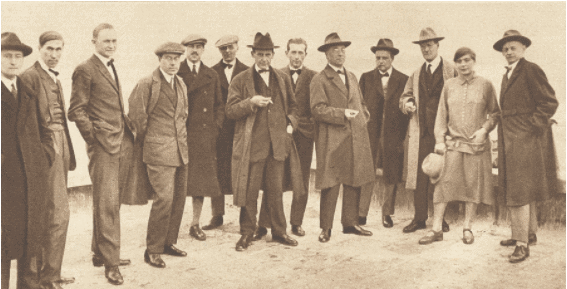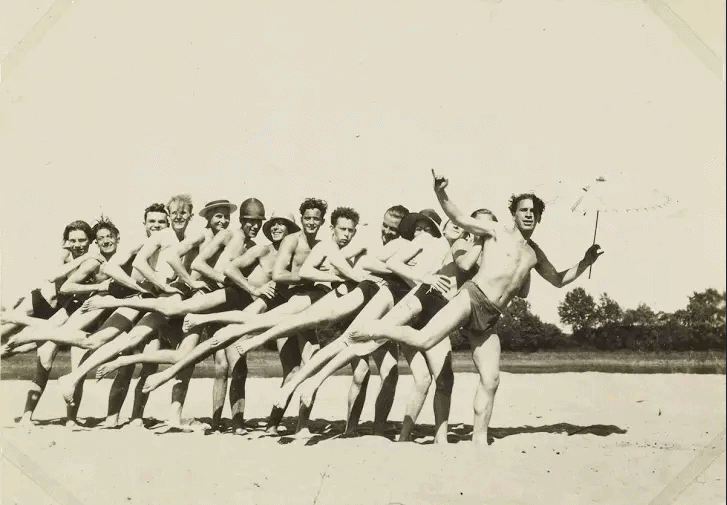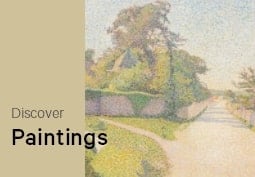Articles and Features
Art Movement: Bauhaus –
Towards the Unity of All the Arts
“Architects, sculptors, painters—we all must return to craftsmanship! For there is no such thing as ‘art by profession.’ There is no essential difference between the artist and the artisan. The artist is an exalted artisan.”
Walter Gropius
Bauhaus definition: what is the Bauhaus movement?
Founded in 1919 by architect Walter Gropius in Weimar, the Staatliches Bauhaus, more commonly known as the Bauhaus, was a German art school that helped birth an art movement and the careers of innumerable artists and architects. Named after the German word meaning literally ‘house of building, Bauhaus’ focus was on the concept of Gesamtkunstwerk (the ‘total work of art’), aiming to combine all arts in one place and under a united ideology, from fine art to industrial design, from graphic design to typography, interior design, and architecture.
Key dates: 1919-1933
Key regions: Weimar, Dessau, and Berlin, Germany
Key artists: Walter Gropius, Ludwig Mies van der Rohe, Paul Klee, Wassily Kandinsky, and László Moholy-Nagy

Newsprint. From Das Illustrierte Blatt, Jan and Edith Tschichold Papers, 1899–1979. The Getty Research Institute, 930030
Origins of the Bauhaus movement
Following the delays caused by World War I and a long-standing debate over the reconciliation of the fine arts and the applied arts, German architect Walter Gropius was made director of a new institution, the soon-to-be Bauhaus, integrating the Grand-Ducal Saxon Academy of Fine Art and the Grand Ducal Saxon School of Arts and Crafts. Gropius’ fellow faculty members were Swiss painter Johannes Itten, German-American painter Lyonel Feininger, and German sculptor Gerhard Marcks, but soon their ranks would comprise German painter, sculptor, and designer Oskar Schlemmer who headed the theatre workshop, and Swiss painter Paul Klee, joined in 1922 by Russian painter Wassily Kandinsky and in 1923 by Russian Constructivist artist and architect El Lissitzky. Founded in Weimar, in 1925 the Bauhaus moved to Dessau in 1925 where it experienced its most fruitful period of activity, ultimately moving to Berlin in 1932 under the direction of the architect Ludwig Mies van der Rohe,
Key ideas behind the Bauhaus movement
Aiming to use many art forms for a single work, to create a piece that is a synthesis of art, at Bauhaus all pupils were working in tandem with their peers: fabric artists, painters, sculptors, furniture designers, architects, and many more. Moreover, Bauhaus teachers and students were united in a design approach of marrying mass production with individual vision, designing and crafting pieces to combine aesthetics and beauty with function and utility. The result of such an ideology was numerous buildings, paintings, drawings, textiles, and designs that helped to define our cultural lexicon and spread modern design around the world.
“God is in the details.”
Ludwig Mies van der Rohe
Famous Bauhaus Artists
Though countless volumes could be written about the famous artists that came out of, or contributed to the Bauhaus movement, here is just a small sampling of the talent nurtured at the unique institution. In addition to the artists below, the school nurtured the careers of Paul Klee, László Moholy-Nagy, Franz Ehrlich, Lilly Reich, Marcel Breuer, Adolf Meyer, and countless others.
Walter Gropius
Founder of the Bauhaus, Walter Gropius was a German architect and a master of modernist architecture. Devoting his energy to finding and nurturing an exceptional staff, he brought the artistic minds of Paul Klee, Johannes Itten, Anni and Josef Albers, Herbert Bayer, László Moholy-Nagy, Otto Bartning and Wassily Kandinsky together as faculty of the Bauhaus. Additionally, he oversaw the school’s shift from Weimar to Dessau and designed the infamous Dessau building himself, which would be the home of the school and the site of designer and architect pilgrimages to this day. Gropius left the Bauhaus in 1928 and went on to become the leading architect of the International Style, crafting iconic buildings such as the Harvard Graduate Center in Cambridge, Massachusetts, the John F. Kennedy Federal Office Building in Boston, Massachusetts and the Pan Am Building (now the Metlife Building) in New York City, among countless others.
Ludwig Mies van der Rohe
The last director of the Bauhaus, Mies van der Rohe emigrated to the United States after the school’s dissolvement and became the head of the architecture school at Armour Institute of Technology (later the Illinois Institute of Technology) in Chicago. Mies created a new modernist style, in which plate glass and industrial steel (new materials at the time) defined a minimal sensibility that expressed the spirit of the modern era. He is the architect behind the Barcelona Pavilion, Chicago Federal Complex, Farnsworth House, Seagram Building, and numerous others.
Wassily Kandinsky
Wassily Kandinsky taught at the Bauhaus in the later years of his life and career, after already establishing himself as a foremost abstract painter and art theorist. At the Bauhaus Kandinsky taught the basic design class for beginners, and a course on advanced theory, where he developed a new colour theory based on elements of form psychology. Kandinsky is known today as the pioneer of abstract art, and his work can be found in museums and galleries the world over.
Paul Klee
One of the fathers of abstraction, Paul Klee developed a visionary idiosyncratic style influenced by music and the early avant-garde movements in constant experimentation with different techniques and materials, but also stood out as one of the most influential colour theorist and writers. He taught at the Bauhaus from January 1921 to April 1931 as a “Form” master in the bookbinding, stained glass, and mural painting workshops, but also taught various other subjects. Many of his lectures have been published.
Anni Albers
Anni Albers, German-born textile artist and printmaker, began as a student at the Bauhaus when her husband, Josef Albers took on a ‘Junior Master’ role at the school. She experimented widely with form, material, colour, and texture and developed numerous functional and unique textiles that served as stunning aesthetic pieces as well as absorbing sound and light. She later went on to become the head of the weaving workshop at the Bauhaus, becoming one of the only women in a senior role at the school. After the end of the Bauhaus, the Albers’ moved to the USA and took on teaching positions at the Black Mountain College. Anni Albers has published several books, and her work lives on in museums, galleries, and personal collections around the world.
The legacy of the Bauhaus movement
In 1933, with the rise of Nazism, the Bauhaus was forced to close first its Dessau location, and after a ten-month stint in a former factory in Berlin the Gestapo halted all Bauhaus activities. Upon closure, many of the Bauhaus’ disciples had to seek protection from the Nazi threat in other countries and fled persecution to Britain and the United States. Several artists, such as Anni and Josef Albers, ended up joining the faculty of Black Mountain College, an experimental arts-based school in North Carolina. The dissipation of students and faculty spread the Bauhaus influence and ideology around the world.
The Bauhaus’ talent, tradition, aesthetics, and ideology birthed an artistic and design movement that led the school to become nearly synonymous with German modernism. The school had a profound impact on the future of modern design, architecture, art, and education, providing inspiration for over a decade of aspiring designers.

From the collection of Bauhaus Dessau Foundation
Relevant sources to learn more
Read more about Art Movements and Styles Throughout History
Learn the importance of the Bauhaus on its 100th anniversary
Enjoy our wrap up of the best exhibitions about the Bauhaus
Find out more about Gesamtkunstwerk
Stories of Iconic Artworks: Paul Klee’s Angelus Novus









